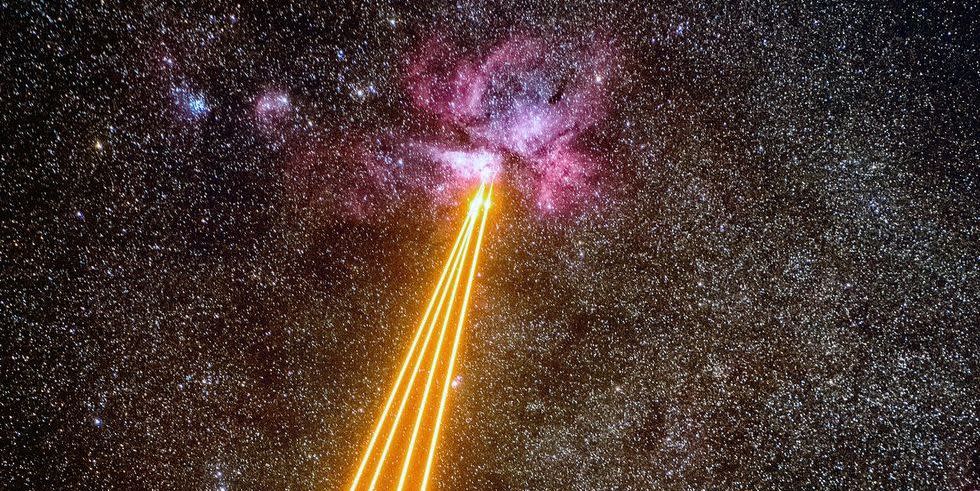Scientists Are Shooting Lasers at This Extremely Badass Nebula

Astronomers at the Very Large Telescope are firing lasers at the Carina Nebula.
The Carina Nebula is one of the most active and brightest nebulas in the sky over the last 200 years.
The Very Large Telescope uses lasers and adaptive optics to correct for turbulence caused by Earth’s atmosphere.
The European Southern Observatory (ESO) recently debuted the stunning image above, which appears to be an epic space battle with a purple cosmic blob, but in reality, shows astronomers using a clever trick to observe one of the largest nebulas in the night sky.
🌌 You love badass space stuff. So do we. Let's explore the universe together.
The Carina Nebula is a stellar nursery of gas and dust surrounding a pair of giant stars called Eta Carinae. Eta Car A, the primary star of the system, is one of the most massive and volatile stars in the sky. Because of the star’s extraordinary mass, it burns through its nuclear fuel like a full-sized SUV, causing it to routinely become unstable over the last 200 years and eject clouds of gas and dust, forming the surrounding nebula.
Astronomers expect the star to explode and go supernova in the next several thousand years. With the star’s history of violent outbursts and possibility to explode, should astronomers really be firing lasers at the heart of the nebula?
ESO is home to what’s considered the world’s most advanced visible-light astronomical observatories, the Very Large Telescope array (VLT). Located in the Atacama Desert of northern Chile, The observatory consists of four Unit Telescopes, each having 27-foot mirrors (8.2 meters) that can warp and deform to correct for turbulence caused by Earth’s atmosphere.
The turbulence is what causes stars to twinkle, which is great for nursery rhymes, but not so much for astronomers, because it blurs their observations of distant stars and galaxies.
🔭 The Best Telescopes for Stargazing
This is where lasers save the day. Using a high-tech adaptive optics facility installed on VLT, astronomers fire powerful lasers toward a target they wish to observe. The laser beams excite sodium particles floating in earth’s upper atmosphere, causing them to glow like artificial stars.
Computers are then able to use the glowing particles as reference stars to measure the distorting effects of the atmosphere. In real time, the computers can adapt the telescopes optics to take images almost as sharp as those taken in space.
The technology has allowed VLT to accomplish a number of astronomy firsts, including the first image taken of a planet outside our solar system, tracking individual stars around the supermassive black hole at the center of our galaxy, and observing the dim glow of the farthest known Gamma-Ray Burst. However, time will tell if Earth will receive any retribution for probing the cosmos with lasers.
Watch This:
You Might Also Like


